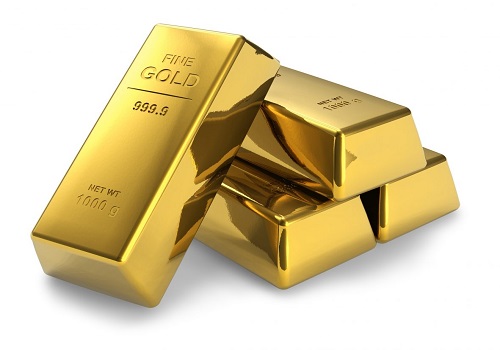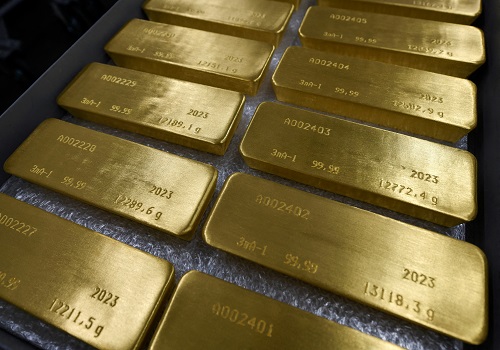Gold`s Record High Shines Amid Concerns of Diminishing Consumer Demand and Geopolitical Uncertainty By Amit Gupta , Kedia Advisory

Follow us Now on Telegram ! Get daily 10 - 12 important updates on Business, Finance and Investment. Join our Telegram Channel
Gold has surged 18.5% in 2024, hitting a record high of $2,483.60 on July 17 and closing at $2,443.29 on August 2. The World Gold Council reported a strong 4% year-on-year increase in Q2 demand, driven by Over The Counter (OTC) investments. However, consumer demand is showing signs of strain due to higher prices, with jewellery consumption dropping 19%, particularly in key markets like China and India. ETFs also saw outflows, and central bank buying slowed. Despite these factors, gold's safe-haven appeal remains strong amid expectations of U.S. interest rate cuts and ongoing geopolitical tensions. The mix of bullish and bearish factors suggests that gold prices may stabilize, with key support around $2,400 and resistance at $2,485 for the rest of the year.
Key Highlights
# Gold has surged 18.5% this year, reaching a record high of $2,483.60 on July 17.
# The World Gold Council reports a 4% year-on-year increase in Q2 demand, driven by OTC markets.
# Jewellery demand fell sharply, especially in China and India, as high prices deterred buyers.
# Central bank purchases and ETF inflows showed signs of slowing in Q2.
# Geopolitical tensions and potential U.S. interest rate cuts could keep gold prices stable.
Gold has been one of the best-performing commodities in 2024, with prices climbing 18.5% year-to-date and reaching an all-time high of $2,483.60 per ounce on July 17. As of August 2, spot gold closed at $2,443.29, holding onto most of its gains. This impressive price performance has been fueled by strong demand, particularly from the Over The Counter (OTC) market, which saw a 53% year-on-year increase in the second quarter, according to the World Gold Council.
However, there are growing concerns that gold's record-breaking run may begin to crimp demand, especially among price-sensitive consumers. The World Gold Council's latest report revealed a significant decline in jewellery demand, which dropped 19% year-on-year to 390.6 tons in the second quarter. China and India, the world's largest consumers of gold, saw particularly steep declines in jewellery demand, with drops of 35% and 17%, respectively. This trend suggests that higher prices are starting to weigh on consumer buying.
In addition, there was a marked slowdown in other areas of demand. Exchange Traded Funds (ETFs) experienced a net outflow of 7.2 tons in Q2, following a significant 113-ton drop in the first quarter. Central bank purchases also eased, totaling 183.4 tons in the second quarter, down from 299.9 tons in the first.
Despite these bearish indicators, gold's safe-haven appeal remains strong, driven by expectations of easing monetary policy, particularly in the U.S., and ongoing geopolitical tensions. These factors may help keep gold prices in a relatively stable range for the remainder of the year.
Gold has surged 18.5% in 2024, hitting a record high of $2,483.60 on July 17 and closing at $2,443.29 on August 2. The World Gold Council reported a strong 4% year-on-year increase in Q2 demand, driven by Over The Counter (OTC) investments. However, consumer demand is showing signs of strain due to higher prices, with jewellery consumption dropping 19%, particularly in key markets like China and India. ETFs also saw outflows, and central bank buying slowed. Despite these factors, gold's safe-haven appeal remains strong amid expectations of U.S. interest rate cuts and ongoing geopolitical tensions. The mix of bullish and bearish factors suggests that gold prices may stabilize, with key support around $2,400 and resistance at $2,485 for the rest of the year.
Key Highlights
# Gold has surged 18.5% this year, reaching a record high of $2,483.60 on July 17.
# The World Gold Council reports a 4% year-on-year increase in Q2 demand, driven by OTC markets.
# Jewellery demand fell sharply, especially in China and India, as high prices deterred buyers.
# Central bank purchases and ETF inflows showed signs of slowing in Q2.
# Geopolitical tensions and potential U.S. interest rate cuts could keep gold prices stable.
Gold has been one of the best-performing commodities in 2024, with prices climbing 18.5% year-to-date and reaching an all-time high of $2,483.60 per ounce on July 17. As of August 2, spot gold closed at $2,443.29, holding onto most of its gains. This impressive price performance has been fueled by strong demand, particularly from the Over The Counter (OTC) market, which saw a 53% year-on-year increase in the second quarter, according to the World Gold Council.
However, there are growing concerns that gold's record-breaking run may begin to crimp demand, especially among price-sensitive consumers. The World Gold Council's latest report revealed a significant decline in jewellery demand, which dropped 19% year-on-year to 390.6 tons in the second quarter. China and India, the world's largest consumers of gold, saw particularly steep declines in jewellery demand, with drops of 35% and 17%, respectively. This trend suggests that higher prices are starting to weigh on consumer buying.
In addition, there was a marked slowdown in other areas of demand. Exchange Traded Funds (ETFs) experienced a net outflow of 7.2 tons in Q2, following a significant 113-ton drop in the first quarter. Central bank purchases also eased, totaling 183.4 tons in the second quarter, down from 299.9 tons in the first.
Despite these bearish indicators, gold's safe-haven appeal remains strong, driven by expectations of easing monetary policy, particularly in the U.S., and ongoing geopolitical tensions. These factors may help keep gold prices in a relatively stable range for the remainder of the year.
Conclusion:
Gold’s price may hover around current levels as bullish factors like geopolitical risks offset weakening consumer demand. Key support is seen near $2,400 with resistance at $2,485.
Gold’s price may hover around current levels as bullish factors like geopolitical risks offset weakening consumer demand. Key support is seen near $2,400 with resistance at $2,485.
Above views are of the author and not of the website kindly read disclaimer










Top News

Government to invite bids for power from 8,000 MW thermal capacities without PPAs: RK Singh
More News

Perspective by Ms.Riya Singh - Research Analyst, Commodities and Currency , Emkay Global Fin...





 320-x-100_uti_gold.jpg" alt="Advertisement">
320-x-100_uti_gold.jpg" alt="Advertisement">







